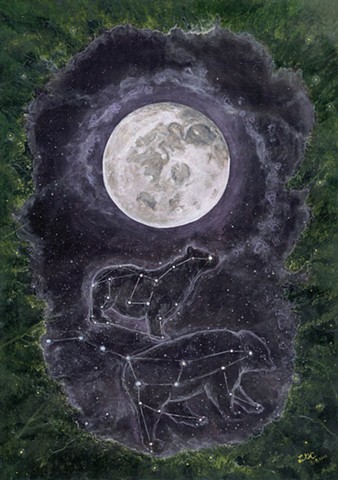Art Work
Ursa Moon, 17x24, acrylic, Copyright 2019, Lelia Canter
“Ursa Moon” features the constellations of Ursa Major and Ursa Minor. The Big and Little Dipper, which are distinctive groups of stars within these constellations, are known as asterisms.
In mythology, Ursa Major was Callisto and Ursa Minor was Arcas, the son of Callisto and Zeus.
Arcas and Callisto were changed into bears and placed in the night sky by Zeus in order to be protected from his jealous wife Hera. Ursa Minor was also once known as Cynosura (Greek for dog’s tail).
The most famous star in Ursa Minor is Polaris, the North Star which is nearest to the North Celestial Pole. It can be used to indicate which direction is north and the angle of Polaris above the horizon tells your latitude on Earth. Because of this, Polaris was the most important star for navigating at sea.
Polaris can be found by first locating the Big Dipper. If you follow the two Pointer Stars (Merak & Dubhe) at the end of the Big Dipper’s cup upwards, the next bright star is Polaris.
Because the Earth is not quite perfectly spherical, the Earth’s axis precesses (similar to a top wobbling as it spins). Precession is caused by the gravitational attraction of the Sun and Moon. Because of precession, in about 14,000 years Polaris will no longer be at the North Pole. Vega will be the North Star and in another 14,000 years after that, Polaris will again be at the North Pole.
“Ursa Moon”, 17x24, acrylic, Lelia Canter ©8/2019.
“Ursa Moon” features the constellations of Ursa Major and Ursa Minor. The Big and Little Dipper, which are distinctive groups of stars within these constellations, are known as asterisms.
In mythology, Ursa Major was Callisto and Ursa Minor was Arcas, the son of Callisto and Zeus.
Arcas and Callisto were changed into bears and placed in the night sky by Zeus in order to be protected from his jealous wife Hera. Ursa Minor was also once known as Cynosura (Greek for dog’s tail).
The most famous star in Ursa Minor is Polaris, the North Star which is nearest to the North Celestial Pole. It can be used to indicate which direction is north and the angle of Polaris above the horizon tells your latitude on Earth. Because of this, Polaris was the most important star for navigating at sea.
Polaris can be found by first locating the Big Dipper. If you follow the two Pointer Stars (Merak & Dubhe) at the end of the Big Dipper’s cup upwards, the next bright star is Polaris.
Because the Earth is not quite perfectly spherical, the Earth’s axis precesses (similar to a top wobbling as it spins). Precession is caused by the gravitational attraction of the Sun and Moon. Because of precession, in about 14,000 years Polaris will no longer be at the North Pole. Vega will be the North Star and in another 14,000 years after that, Polaris will again be at the North Pole.
Limited Edition Prints Available of This Image
Contact lelia@leliacanter.com for pricing and order information
Limited Edition Prints Available.
